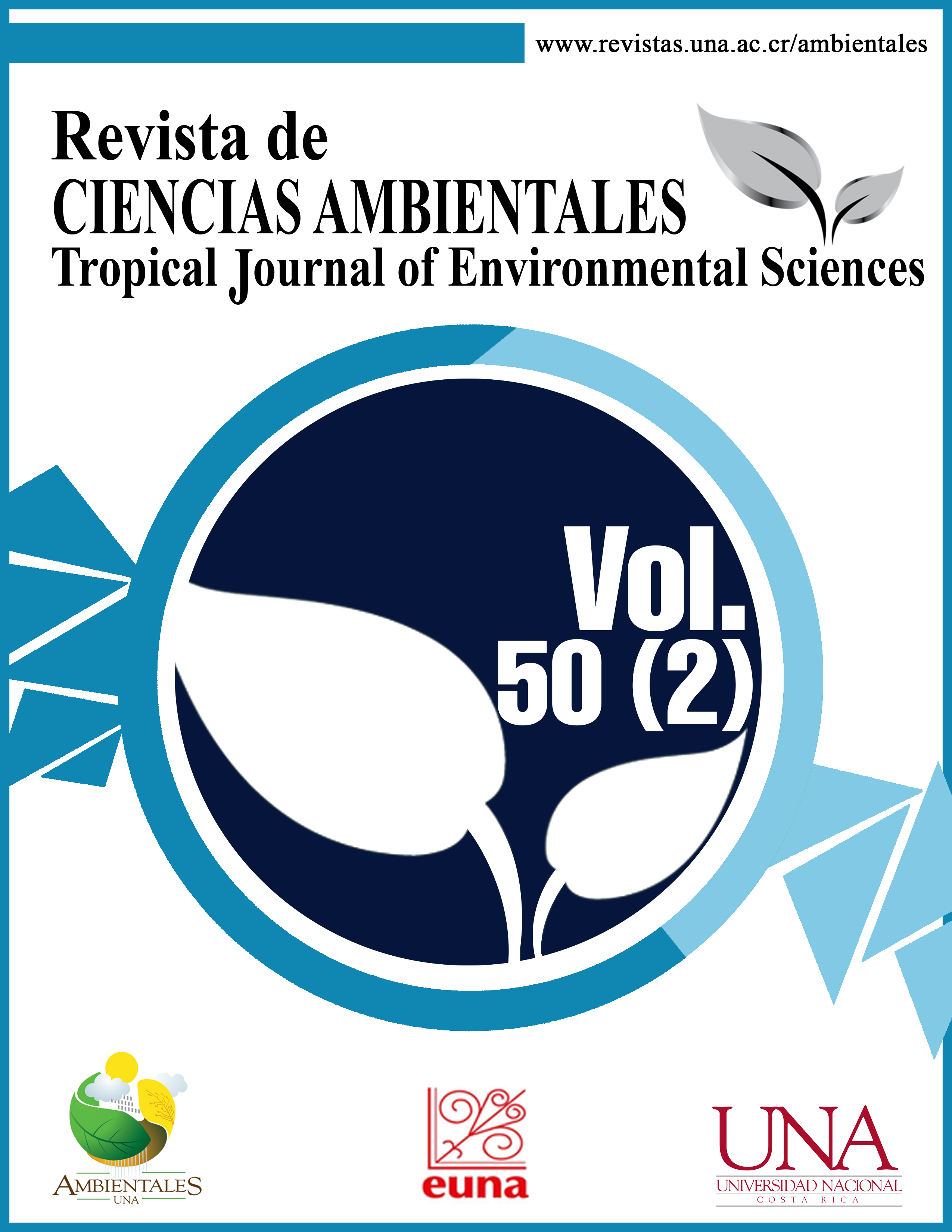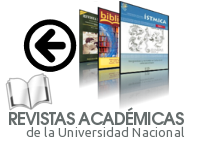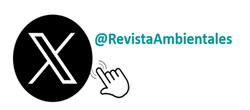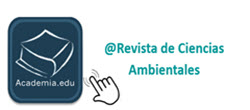Autonomous Adaptation to Extreme Hydrometeorological Events: A Case Study of the Coexistence of an Indigenous Territory with Climate Risk at the Sixaola Basin, Costa Rica
DOI:
https://doi.org/10.15359/rca.50-2.2Keywords:
Adaptability, agriculture, climate, indigenous, traditional knowledge.Abstract
Autonomous adaptation refers to the measures taken by a specific population as a self-managed response to an adverse climate event. The absence of government help or large-scale investments determines the local-scale nature of those initiatives. Observation and traditional knowledge are the basis of this kind of adaptation measures. In this text; we analyzed the process that led the indigenous community; dedicated to agriculture in Sixaola River’s Basin; to take actions for increasing their resilience and adaptation to continuous extreme climate events. A qualitative ethnographic method was used on the basis of a record research on databases and other secondary sources to develop participatory observations; two discussion groups; and a workshop. It was found that women producers of cocoa and their families took measures such as crops diversification; farmer’s associations; community organizations; and village relocation without governmental support. This case offers inputs and lessons learned relevant to the current topic; the adaptation and resilience measures in rural territories.
References
Altamirano, M. A. (2013). Propuestas de adaptación de la producción de cacao en Waslala, Nicaragua ante el cambio climático (Tesis de doctorado). Centro Agronómico Tropical de Investigación y Enseñanza (CATIE), Turrialba, Costa Rica.
Alvarado, L., Contreras, W., Alfaro, M., & Jiménez, E. (2012). Escenarios de cambio climático regionalizados para Costa Rica. San José, Costa Rica.
Bindoff, N. L., Stott, P. A., AchutaRao, M., Allen, M. R., Gillett, N., Gutzler, D. & Mokhov, I. I. (2013). Detection and attribution of climate change: from global to regional. United Kingdom and New York: Cambridge University Press. New York, EUA.
Borge, C. & Castillo, R. (1997). Cultura y conservación en la Talamanca indígena. San José, Costa Rica: EUNED.
Capstick, S. B. & Pidgeon, N. F. (2014). Public perception of cold weather events as evidence for and against climate change. Climatic Change,122, 695. doi: http://dx.doi.org/10.1007/s10584-013-1003-1
Carneiro Ferreira, M., Ferreira da Fonseca, J., Campos da Carvalho, B., Mojica Rodríguez, J., de Obschatko, E., Ganduglia, F., & Díaz, A. (2015). VI Censo nacional agropecuario: Resultados generales (No. L01-27). Instituto Nacional de Estadística y Censos, San José, CR.
Clarke, A. J. (2008) An introduction to the dynamics of El Nino & the Southern Oscillation. Florida, Academic press. Florida, EUA.
Dahlquist, R. M., Whelan, M. P., Winowiecki, L., Polidoro, B., Candela, S., Harvey, C. A., & Bosque-Pérez, N. A. (2007). Incorporating livelihoods in biodiversity conservation: a case study of cacao agroforestry systems in Talamanca, Costa Rica. Biodiversity and conservation, 16(8), 2311-2333. doi: http://dx.doi.org/10.1007/s10531-007-9192-4
Desinventar, (2016). Sistema de inventario de efectos de desastres. Recuperado de http://desinventar.org/es/database
Echeverría, J. (2011). Evaluación de la vulnerabilidad futura del sistema hídrico al Cambio Climático. San José, Costa Rica: IMN-MINAET, PNUD.
Forsyth, T. & Evans, N. (2013). What is autonomous adaption? Resource scarcity and smallholder agency in Thailand. World Development, 43, 56-66. doi: http://dx.doi.org/10.1016/j.worlddev.2012.11.010
Galindo, L. M., Samaniego, J., Alatorre, J. E., Ferrer, J. & Reyes, O. (2014). Cambio climático, agricultura y pobreza en América Latina: Una aproximación empírica. Santiago de Chile. Organización de las Naciones Unidas. Washington, EUA.
García, R. A., Cabeza, M., Rahbek, C. & Araújo, M. B. (2014). Multiple dimensions of climate change and their implications for biodiversity. Science, 344(6183), 486-496. doi: http://dx.doi.org/10.1126/science.1247579
García-Serrano, C. R., & Del Monte, J. P. (2004). The use of tropical forest (agroecosystems and wild plant harvesting) as a source of food in the bribri and cabecar cultures in the Caribbean Coast of Costa Rica. Economic botany, 58(1), 58-71. doi: http://dx.doi.org/10.1663/0013-0001(2004)058[0058:TUOTFA]2.0.CO;2
Gutiérrez, M. E. & Espinosa, T. (2010). Vulnerabilidad y adaptación al cambio climático. Diagnóstico inicial, avances, vacíos y potenciales líneas de acción en Mesoamérica. BID, Washington, DC. (Versión del Banco Interamericano de Desarrollo). Recuperado de http://www.uncclearn.org/sites/default/files/inventory/idb21_spn.pdf
Instituto Meteorológico Nacional y Retana, J. (Ed.). (2012). Mejoramiento de las capacidades nacionales para la evaluación de la vulnerabilidad y adaptación del sistema hídrico al cambio climático en Costa Rica, como mecanismo para disminuir el riesgo al cambio climático y aumentar el Índice de Desarrollo Humano (Informe final). Instituto Meteorológico Nacional (IMN). San José, Costa Rica: Programa Naciones Unidas para el Desarrollo.
Instituto Meteorológico Nacional. (2008). Clima, variabilidad y cambio climático en costa Rica. En Segunda Comunicación Nacional sobre Cambio Climático. San José, Costa Rica: Ministerio Nacional de Ambiente, Energía y Telecomunicaciones (MINAET): Comité Regional de Recursos Hidráulicos (CRRH): PNUD.
Jacobi, J., Schneider, M., Bottazzi, P., Pillco, M., Calizaya, P. & Rist, S. (2015). Agroecosystem resilience and farmers’ perceptions of climate change impacts on cocoa farms in Alto Beni, Bolivia. Renewable Agriculture and Food Systems, 30(02), 170-183. doi: http://dx.doi.org/10.1017/S174217051300029X
Ministerio de Agricultura y Ganadería. (2011). Plan de acción para el cambio climático y la gestión agroambiental (2011-2014). Recuperado de https://drive.google.com/file/d/0B9k5_sN_eAC8ek1sRVlIZUhOcnM/view.
Malik A., Qin, X. & Smith, S. (2010). Autonomous adaptation to climate change: A literature review. Working Paper Series. The George Washington University, Institute for International Economic Policy, Elliott School of International Affairs. EUA.
Marshall, J. & Plumb, R. A. (2013). Atmosphere, ocean and climate dynamics: an introductory text. Milwaukee, Wisconsin. EUA: Academic Press.
McDowell, G., Stephenson, E., & Ford, J. (2016). Adaptation, Adaptation Science, and the Status of Adaptation in Mountain Regions. Columbia, EUA: Springer International Publishing.
McNamara, K. E., & Prasad, S. S. (2014). Coping with extreme weather: communities in Fiji and Vanuatu share their experiences and knowledge. Climatic change, 123(2), 121-132. doi: http://dx.doi.org/10.1007/s10584-013-1047-2
Ministerio de Ambiente, Energía y Telecomunicaciones, Calderón y Alvarado (Eds.). (2009). Estrategia nacional de cambio climático. San José, Costa Rica: Autor
Molina-Murillo, S. A., Castillo, J. P., & Ugalde, M. E. (2014). Assessment of environmental payments on indigenous territories: The case of Cabecar-Talamanca, Costa Rica. Ecosystem Services, 8, 35-43. doi: http://dx.doi.org/10.1016/j.ecoser.2014.02.003
National Weather Service. (2016). Cold & warm episodes by season. Recuperado http://www.cpc.ncep.noaa.gov/products/analysis_monitoring/ensostuff/ensoyears.shtml
Nkomwa, E. C., Joshua, M. K., Ngongondo, C., Monjerezi, M., & Chipungu, F. (2014). Assessing indigenous knowledge systems and climate change adaptation strategies in agriculture: A case study of Chagaka Village, Chikhwawa, Southern Malawi. Physics and Chemistry of the Earth, Parts A/B/C, 67, 164-172. doi: http://dx.doi.org/10.1016/j.pce.2013.10.002
Nyong, A., Adesina, F., & Elasha, B. O. (2007). The value of indigenous knowledge in climate change mitigation and adaptation strategies in the African Sahel. Mitigation and Adaptation strategies for global Change, 12(5), 787-797. doi: http://dx.doi.org/10.1007/s11027-007-9099-0
Parry, M. L., Canziani, O. F., Palutikof, J. P., Van der Linden, P. J. & Hanson, C. E. (2007). Contribution of working group II to the fourth assessment report of the intergovernmental panel on climate change, 2007. Climate Change 2007: Working Group II: Impacts, Adaptation and Vulnerability. Cambridge University Press, Cambridge, United Kingdom and New York, USA. Recuperado de http://www.ipcc.ch/publications_and_data/publications_ipcc_fourth_assessment_report_wg2_report_impacts_adaptation_and_vulnerability.htm
Renaud, F. G., Nehren, U., Sudmeier-Rieux, K., & Estrella, M. (2016). Developments and Opportunities for Ecosystem-Based Disaster Risk Reduction and Climate Change Adaptation. In Ecosystem-Based Disaster Risk Reduction and Adaptation in Practice (pp. 1-20). Columbia, EUA: Springer International Publishing. doi: http://dx.doi.org/10.1007/978-3-319-43633-3
Sánchez, I., Díaz, G., Cavazos, P. M., Granados, R. R. & Gómez, R. E. (2011). Elementos para entender el cambio climático y sus impactos. D.F, México: Grupo Editorial Miguel Ángel Porrúa.
Sietz, D., Choque, S. E. M., & Lüdeke, M. K. (2012). Typical patterns of smallholder vulnerability to weather extremes with regard to food security in the Peruvian Altiplano. Regional Environmental Change, 12(3), 489-505. doi: http://dx.doi.org/10.1007/s10113-011-0246-5
Smith, B. & Pilifosova, O. (2003). Adaptation to climate change in the context of sustainable development and equity. Sustainable Development, 8(9), 9.
Somarriba, E., Suárez-Islas, A., Calero-Borge, W., Villota, A., Castillo, C., Vílchez, S., & Cerda, R. (2014). Cocoa–timber agroforestry systems: Theobroma cacao–Cordia alliodora in Central America. Agroforestry systems, 88(6), 1001-1019. doi: http://dx.doi.org/10.1007/s10457-014-9692-7
Stocker, T. F., Qin, D., Plattner, G. K., Tignor, M., Allen, S. K., Boschung, J... V., & Midgley, B. M (Eds). (2013). IPCC, 2013: climate change 2013: the physical science basis. Contribution of working group I to the fifth assessment report of the intergovernmental panel on climate change. Cambridge, United Kingdom and New York, NY, USA. Cambridge University Press.
Sylvester, O., Segura, A. G., & Davidson-Hunt, I. J. (2016). Wild Food Harvesting and Access by Household and Generation in the Talamanca Bribri Indigenous Territory, Costa Rica. Human Ecology, 44(4), 449-461. doi: http://dx.doi.org/10.1007/s10745-016-9847-4
Tignor, M. & Miller, H. (2007). Contribution of Working Group I to the Fourth Assessment Report of the Intergovernmental Panel on Climate Change, 2007. Cambridge University Press, Cambridge, United Kingdom and New York, EUA. Recuperado de http://www.ipcc.ch/publications_and_data/ar4/wg1/en/contents.html
United Nations Development Programme (2011) Mainstream climate change adaptation adaptation into development planning: a guide for practitioners. Nairobi, Kenya: UNDP-UNEP.
Wang, C., Deser, C., Jin-Yi, Y., DiNezio, P. & Clement, A. (2012). El Niño and Southern Oscillation (ENSO). Coral reefs of the Eastern Pacific, 3-19.
Whelan, M. P. (2005). Reading the Talamanca landscape: land use and livelihoods in the Bribri and Cabécar indigenous territories (Tesis de maestría). Centro Agronómico Tropical de Investigación y Enseñanza (CATIE), Turrialba, Costa Rica.
Younus, M. A. F. (2014). Failure Effects of Autonomous Adaptation. Bangladesh: Springer Netherlands. doi: http://dx.doi.org/10.1007/978-94-007-5494-2_7
Downloads
Published
How to Cite
Issue
Section
License

This work is licensed under a Creative Commons Attribution-NonCommercial-ShareAlike 4.0 International License.



















